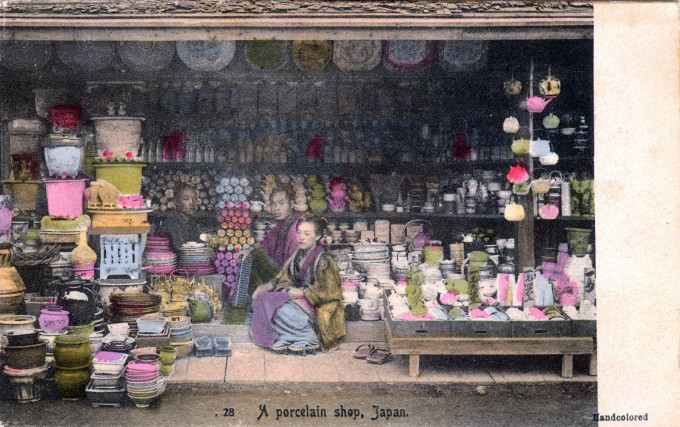“According to Dr. Rein, the manufacture of Porcelain at Arita is generally traced to Gorodayu Shonsui, a potter of Ise Province who lived at the beginning of the 16th cent. and was the first in Japan to manufacture porcelain proper as distinguished from pottery.
“Moved by the beauty and value of Chinese porcelain which began to reach Japan at this time he undertook a journey to King-te-tschin via Fuchow and remained there 5 yrs. to learn the trade. Returning in 1514 he settled in the then-insignificant town of Arita and prepared from the materials he had brought from China a number of coarse porcelain wares decorated under glaze with blue cobalt. When his stock of Chinese porcelain material was exhausted and he found himself obliged to depend on domestic clay. He could make nothing but faience as did his successors to the end of the century with cobalt decoration under glaze.
“Ceramics received a new impulse here and in many other parts of Japan with the return of Hideyoshi’s army from Korea (in 1598). A Nabe-shima Naoshige, the daimyo of Hizen Province and one of the commanders of the Japanese troops in Korea, brought back with him several Korean potters who settled first in the bathing resort of Ureshimo but later in Arita. One of them, Risampei, discovered in 1599 porcelain stone on the Idzumi-yama E. of Arita and at once began the manufacture of porcelain in Japan.
“For centuries Arita furnished the most highly valued wares of Japan; its porcelain was perfectly uniform and, besides adding considerable translucence to pure white, was hard enough for all the purposes of ordinary life. It burns so easily that decorative art has in its surface as in that of faience, a fine field, and is aided also by the plastic character of the excellent material.
“Certain of Kakiemon’s early masterpieces were of milk white porcelain generally with scanty designs in vitrifiable enamels. These delicate designs were too tame for the Dutch traders who suggested that the potters should add enamel decoration over the glaze to pieces already decorated with blue under the glaze. ‘There thus came into existence’ (says Brinkley) ‘the familiar Imari-yaki; the ‘Old Japan’ of Western amateurs; the Nishiki-de or ‘Brocade Pattern’ of the Japanese themselves. It was a brilliant ware depending chiefly upon wealth of decoration and richness of coloring.”
– Terry’s Japanese Empire, T. Philip Terry, 1914
Imari (Japanese) porcelain, c. 1900.
1900s • Arts & Culture • Commerce
Tagged with: Imari ware, Porcelain, Pottery
Please support this site. Consider clicking an ad from time to time. Thank you!


